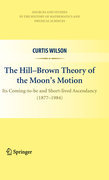
The Hill-Brown theory of the Moon’s motion: its coming-to-be and short-lived ascendancy (1877-1984)
Wilson, Curtis
This book, in three parts, describes three phases in the development of the modern theory and calculation of the Moon's motion—the last of which, in 1984, resulted in the transfer in the responsibility of producing lunar tables from the Nautical Almanac Office in Washington, D.C., to the Jet Propulsion Laboratory in Pasadena, CA—definitively ending an era. The mathematical, philosophical, and historical interest in the analytic solution to the lunar problem usingthe Hill–Brown method still engages celestial mechanicians and is the primaryfocus of this work. Part I explains the crisis in lunar theory in the 1870s that led G.W. Hill to lay a new foundation for an analytic solution, a preliminary orbit he called the 'variational curve.' Part II is devoted to E.W. Brown's completion of the new theory as a series of successive perturbations of Hill's variational curve. Part III describes the revolutionary developments in time-measurement and the determination of Earth-Moon and Earth-planet distances that led to the retirement of the Hill–Brown theory in 1984. The book uses somecalculus and differential equations, but the text is largely understandable without advanced knowledge in these areas. Amateurs of astronomy, as well as instructors and scholars of the general history of science, would find this bookof significant interest. Illustrates the complete history of the theory begunby G.W. Hill through to its completion by E.W. Brown Numerous historical accounts reveal how and why perspectives on the lunar problem have changed over time Uniquely present the set of lunar properties that made the moon a more difficult subject for celestial mechanicians than any other celestial body Provides elementary explanation of the dynamics involved in the Hill-Brown theory making the book accessible to the non-professional INDICE: Preface.- Part I. Hill lays the foundation (1877-1878).- Part II. Brown completes the theory (1892-1908) and constructs tables (1908-1919).- Part III. Revolutionary developments in time measurement, computing, and data collection.- Appendix.- Index.
- ISBN: 978-1-4419-5936-2
- Editorial: Springer
- Encuadernacion: Cartoné
- Páginas: 323
- Fecha Publicación: 17/06/2010
- Nº Volúmenes: 1
- Idioma: Inglés
